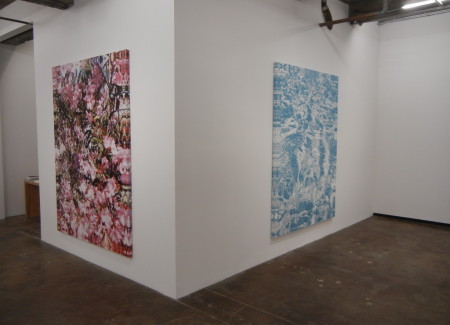JTF (just the facts): A total of 10 large scale paintings, hung unframed against white walls in the two room gallery space. All of the works are acrylic lacquer on canvas, made between 1997 and 2002. Physical sizes range from roughly 94×72 (or reverse) to 84×112, and the works are available in editions of 2+1AP. (Installation shots and detail images below.)
Comments/Context: The dividing line between photography and painting has become so muddy in the past few years that attempting to draw a crisp definitional line between the two seems almost futile. Countless artists who call themselves painters (Richard Prince, Wade Guyton, Kelley Walker, and many others) have brought photographs into their work, using inkjet printing technology to print directly on canvas or other substrates. And increasingly, the gestural hand crafting of the artist is taking place in the digital realm, before the image is ever given its final physical form.
Back a decade or two ago, this blurring of borders was much less prevalent, and Jack Pierson’s photographic paintings from the late 1990s and early 2000s feel like an intermediate step between the formerly discrete mediums and our more broadly fluid world. If we want to chart the entire historical path, we can go back even further to the experiments with lithography and screen printing technologies that initially made painterly image appropriation possible, and were then extended and reimagined by artists from Warhol to Rauschenberg.
Pierson’s paintings were made using state-of-the-art (at the time) billboard printing technology, breaking the images down into millions of tiny dots (see the image details above). They have a machined feel, an industrial perfection that was more extreme than what had come before – there is no gesture, no painterly chance, no hand crafting, just pure, unadulterated photographic reproduction in paint, available in an edition rather than as a single unique object. With the benefit of hindsight, there’s clearly a connective line that can be chronologically drawn back to Lichtenstein’s Ben Day dots and all the way forward to current pixelization, with this technology somewhere in between.
In the late 1980s, Jeff Koons had done something similar with his infamous Made in Heaven photographic paintings, but Pierson’s works are clearly more grounded in photographic seeing and conceptual inversion. Many are close up over enlargements, where recognizable subjects become obscure as they are magnified into blurs. Thickets of flowers and dappled water surfaces break down into all over pattering, while glistening lips become fuzzy and indeterminate and a series of images of male masturbation are transformed into elongated abstractions in indistinct red and white. And one work brings the game full circle – it’s a an image of lightly tinted pink canvas, or a painting of a photo of a painting.
Walking through the galleries here, I had the distinct sense of these works being transitional. In the context of Koons on one side and the Düsseldorf photographers making monumentally crisp pictures to attack painting on the other, Pierson’s works feel more contrarian and counter, like he was looking for an alternate way to leverage and reconsider photographic imagery in its relationship to painting. Seen today, they have a straightforward simplicity that seems a bit obvious, but at that time, the enlargement of a photograph and the transfer to canvas likely felt more subversive than it does now. These works foreshadow what would come later, and that’s where their durable importance lies.
Collector’s POV: The works in this show are priced at either $65000 or $75000 based on size. Jack Pierson is represented by Cheim & Read in New York (here) and Regen Projects in Los Angeles (here) among others. His photographs have been intermittently available in the secondary markets in recent years, with prices ranging between roughly $2000 and $38000.











